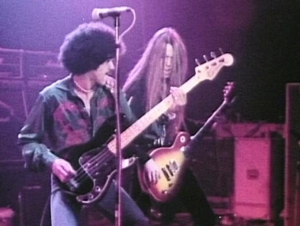The 5 Greatest Isolated Drum Tracks From Phil Collins

Youtube / PhilGenesisDB
Before Phil Collins was serenading stadiums with heartfelt ballads, he was mastering the drums with unshakable precision. His passion for rhythm wasn’t a side hobby—it was his foundation. He once said, “I’m a drummer that sings a bit,” and that distinction is crucial. For all the fame he earned as a frontman, Collins’ legacy behind the kit is where his technical brilliance truly shines.
From prog-rock complexity to tight, punchy pop grooves, Collins has shown an uncanny ability to shift styles while still sounding unmistakably like himself. Whether backing Genesis during their ambitious early years or contributing to collaborations with rock heavyweights, he always brought a level of finesse and fire that elevated every track he touched. Even when the spotlight shifted to his voice, the drums never stopped being his truest instrument.
This list dives into five isolated drum performances that highlight just how versatile—and powerful—Phil Collins is behind a kit. Stripped of production gloss and vocal layers, these raw recordings expose the intricacies, the energy, and the emotion of a drummer in full command of his craft.
View this post on Instagram
“Firth of Fifth” (1973)
Peter Gabriel had high standards when it came to drummers, and the early Genesis records never quite met them—until Phil Collins entered the picture. His arrival brought newfound precision and creativity behind the kit, quickly winning over Gabriel and the rest of the band. On “Firth of Fifth,” Collins made his presence known, even if the track’s spotlight leaned toward piano and guitar.
At first glance, it may seem like a quieter moment for a drummer, overshadowed by Tony Banks’ sweeping piano and Steve Hackett’s iconic guitar solo. But listen closely to the isolated drum track, and you’ll hear the subtle finesse Collins brings. He’s not just keeping time—he’s adding texture and depth to a sprawling prog-rock composition.
Collins’ drumming here is an example of restraint meeting skill. Even when the drums aren’t the main event, he injects complexity and emotion. The syncopation, timing shifts, and seamless integration into a layered track demonstrate why his drumming didn’t just support Genesis—it shaped them.
“Los Endos” (1976)
When Peter Gabriel left Genesis, it felt like the end of an era. Instead, it was the beginning of Phil Collins stepping forward—not just as a singer, but as a drummer who still had a lot to say with his sticks. “Los Endos,” an instrumental from A Trick of the Tail, gave him full license to go wild—and he delivered.
Playing alongside Chester Thompson, Collins treated the track like a masterclass in rhythmic storytelling. The energy constantly surges and shifts, and Collins keeps pace with intricate fills and precise execution. Their dual drumming setup added extra dimension, with Collins rising to the challenge with the same intensity and skill that marked his best studio work.
What’s even more impressive is that much of the original recording was double-tracked—Collins literally laid down each beat twice, with flawless timing. That attention to detail and performance quality is what makes the isolated drums on “Los Endos” such a rewarding listen. You’re hearing a drummer so comfortable in his role that even complexity feels effortless.
“Eleventh Earl of Mar” (1976)
Genesis’ Wind & Wuthering is often hailed as one of their most elegant and refined records, and “Eleventh Earl of Mar” is a standout in both composition and performance. Collins wasn’t just playing drums anymore—he was beginning to establish himself as a dual threat, both singing and drumming with increasing confidence.
This track highlights a shift in Collins’ approach. You can hear his Motown and soul influences beginning to bleed into the playing, resulting in a fusion of prog-rock precision with groove-driven flair. His fills are fast but fluid, and his timing anchors a track full of lyrical shifts and musical motifs.
More than just rhythm, Collins adds drama to the piece. The way he builds momentum, responds to the guitars, and punches up the chorus with tight accents shows a drummer fully in command. “Eleventh Earl of Mar” proves that even in Genesis’ more structured arrangements, there was room for Collins to stretch out and innovate.
“In The Air Tonight” (1980)
“In the Air Tonight” is arguably the most iconic drum moment in pop history—and somehow, it wasn’t even originally meant for Genesis. The band passed on the track, allowing Collins to keep it for himself. That decision turned into gold, especially once that thunderous drum fill exploded into popular culture.
Isolated, the drums tell an even more gripping story. You can hear the eerie restraint in the opening measures, building tension like a suspense film. Then comes the legendary moment: a gated reverb crash that still hits like a punch in the chest, even decades later. It was a production trick born from experimentation, and it changed how drums would be recorded for years to come.
But it wasn’t just about studio magic. Collins’ sense of timing, space, and emotional weight made this a benchmark track. Whether you’re analyzing the playing or just soaking in the mood, “In the Air Tonight” remains a high-water mark—not just for Phil Collins, but for drumming as an expressive art form.
“Easy Lover” (1984)
By the mid-80s, Phil Collins had become a ubiquitous force—fronting Genesis, releasing solo hits, and working with just about everyone. Amid all this, he still found time to deliver razor-sharp drumming on “Easy Lover,” a duet with Philip Bailey that turned into a global smash.
Collins knew exactly when to pull back and when to punch through. Instead of flashy fills, he offered a refined, punchy groove that gave the track its infectious drive. The drums don’t demand attention—but once you isolate them, you realize they’re doing a lot more than holding the beat. They breathe, bounce, and elevate Bailey’s vocals with subtle sophistication.
Perhaps most impressively, the song was born out of a jam session. Collins co-wrote it on the spot, and his natural feel for rhythm is baked into every second of the recording. “Easy Lover” might not have the drama of “In the Air Tonight,” but its groove and control are just as masterful—and a fitting finale for this list of his greatest isolated drum moments.
















